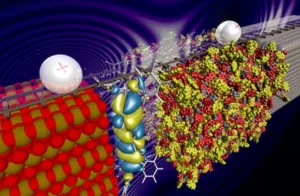In the recently published article ‘Universal strategy for Ohmic hole injection into organic semiconductors with high ionization energies‘ by Naresh B. Kotadiya et. al. from the Max Planck Institute for Polymer Research in Mainz, Germany and the Institute of Scientific and Industrial Research (ISIR), Osaka University, Ibaraki, Japan, there is a description of a method to increase the hole injection current into organic semiconductors by a factor of ten or more. This would increase the efficiency of AMOLED displays as a practical application.
The method consists of creating a very thin layer of organic compounds between the metal electrode and the organic semiconductor. The layer is only a few nanometers thick and it seems that the actual compound does not matter very much as long as it has a higher IE (ionization energy) than the organic semiconductor.
A thin layer of material increases the hole injection current into organic semiconductors credit:MaxPlanck Institute
The authors explain the effect through decoupling and realignment of the electrode’s Fermi level with the IE of the organic semiconductor. The paper also includes a theoretical discussion and a model confirming the experimental results.
Analyst Comment
Putting an organic semiconductor with an even higher ionization energy in between an electrode and the organic semiconductor seems counterintuitive at the first moment, but seems to have a significant effect on the hole injection current. Besides the obvious application in OLED displays the technique should also affect the efficiency of organic solar cells and field effect transistors. (NH)

